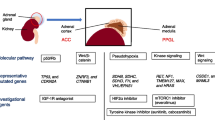Abstract
In recent years, familial pheochromocytoma (PHEO) with germline mutations in the MAX (MYC associated factor X) gene has been reported in a few cases. Here, we investigated a 25–year-old patient with multiple PHEOs associated with a non-sense germline MAX mutation. Preoperative 18F-FDOPA PET/CT revealed bilateral adrenal involvement with multiple tumors. In addition, both adrenal glands were found to have diffuse or nodular adrenal medullary hyperplasia (AMH), a histopathological feature previously described as a precursor of MEN2- and SDHB-related PHEOs but not MAX. After bilateral adrenalectomy, different paraffin-embedded and frozen samples were analyzed for allelic imbalances of the MAX gene using allelic quantification by pyrosequencing. The expression of the protein MAX was studied by immunohistochemistry. All PHEOs but also nodular AMH exhibited a loss of the normal allele. By contrast, the diffuse AMH did not show loss-of-heterozygosity. Nevertheless, immunohistochemistry demonstrated loss of protein MAX expression in all samples including diffuse hyperplasia, suggesting a causative role of MAX mutation for both PHEOs and AMH. The present case shows that both nodular and diffuse AMH belongs to the spectrum of MAX-related disease. These data support the possible continuum between nodular AMH and PHEO, expanding the qualification of micro-PHEO to nodular AMH.




Similar content being viewed by others
References
Curras-Freixes M, Inglada-Perez L, Mancikova V et al. Recommendations for somatic and germline genetic testing of single pheochromocytoma and paraganglioma based on findings from a series of 329 patients. J Med Genet 52: 647–656, 2015.
Korpershoek E, Petri BJ, Post, E et al. Adrenal medullary hyperplasia is a precursor lesion for pheochromocytoma in MEN2 syndrome. Neoplasia 16: 868–873, 2014.
Grogan RH, Pacak K, Pasche L, Huynh TT, Greco RS Bilateral adrenal medullary hyperplasia associated with an SDHB mutation. J Clin Oncol 29: e200–202, 2011.
Comino-Mendez I, Gracia-Aznarez FJ, Schiavi F et al. Exome sequencing identifies MAX mutations as a cause of hereditary pheochromocytoma. Nat Genet 43: 663–667, 2011.
Kwok CT, Hitchins MP Allele Quantification Pyrosequencing (R) at Designated SNP Sites to Detect Allelic Expression Imbalance and Loss-of-Heterozygosity. Methods Mol Biol 1315: 153–171, 2015.
Cascon A, Inglada-Perez L, Comino-Mendez, I et al. Genetics of pheochromocytoma and paraganglioma in Spanish pediatric patients. Endocr Relat Cancer 20: L1-L6, 2013.
Cascon A, Robledo M MAX and MYC: a heritable breakup. Cancer Res 72: 3119–3124, 2012.
Casey SC, Tong L, Li, Y et al. 2016 MYC regulates the antitumor immune response through CD47 and PD-L1. Science
Burnichon N, Cascon A, Schiavi F, et al. MAX mutations cause hereditary and sporadic pheochromocytoma and paraganglioma. Clinical cancer research : an official journal of the American Association for Cancer Research 18: 2828–2837, 2012.
Peczkowska M, Kowalska A, Sygut J et al. Testing new susceptibility genes in the cohort of apparently sporadic phaeochromocytoma/paraganglioma patients with clinical characteristics of hereditary syndromes. Clinical Endocrinology 79: 817–823, 2013.
Kimura N A Pathologist’s view: molecular profiles for diagnosing pheochromocytomas and paragangliomas. Int J Endocrine Onc: 193–200, 2015.
Flynn A, Dwight T, Harris, J et al. Pheo-Type: A Diagnostic Gene-expression Assay for the Classification of Pheochromocytoma and Paraganglioma. J Clin Endocrinol Metab 101: 1034–1043, 2016.
Lack EE Tumors of the Adrenal Gland and Extraadrenal Paraganglia. Washington, DC: American Registry Of Pathology: 231–240, 2007.
DeLellis RA, Wolfe HJ, Gagel, R.F et al. Adrenal medullary hyperplasia. A morphometric analysis in patients with familial medullary thyroid carcinoma. Am J Pathol 83: 177–196, 1976.
Favier J, Amar L, Gimenez-Roqueplo AP Paraganglioma and phaeochromocytoma: from genetics to personalized medicine. Nat Rev Endocrinol 11: 101–111, 2015.
Acknowledgment
AST receives grant support from The Pheo Para Alliance.
Author information
Authors and Affiliations
Corresponding author
Ethics declarations
Conflict of Interest Declaration
The authors declare that they have no conflict of interest.
Informed Consent
Informed consent was obtained from all individual participants included in the study.
Source of Support
The French Ministry of Health supports this work.
Electronic supplementary material
ESM 1
(PDF 3526 kb)
Rights and permissions
About this article
Cite this article
Romanet, P., Guerin, C., Pedini, P. et al. Pathological and Genetic Characterization of Bilateral Adrenomedullary Hyperplasia in a Patient with Germline MAX Mutation. Endocr Pathol 28, 302–307 (2017). https://doi.org/10.1007/s12022-016-9460-5
Published:
Issue Date:
DOI: https://doi.org/10.1007/s12022-016-9460-5




